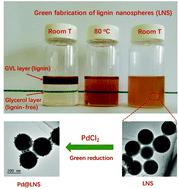当前位置:
X-MOL 学术
›
Green Chem.
›
论文详情
Our official English website, www.x-mol.net, welcomes your
feedback! (Note: you will need to create a separate account there.)
Fabrication of lignin nanospheres by emulsification in a binary γ-valerolactone/glycerol system and their application as a bifunctional reducer and carrier for Pd nanoparticles with enhanced catalytic activity
Green Chemistry ( IF 9.3 ) Pub Date : 2020-10-26 , DOI: 10.1039/d0gc02424d Guanhua Wang 1, 2, 3, 4, 5 , Tairan Pang 1, 2, 3, 4, 5 , Shilin Chen 1, 2, 3, 4, 5 , Wenjie Sui 4, 5, 6, 7, 8 , Chuanling Si 1, 2, 3, 4, 5 , Yonghao Ni 9, 10, 11, 12
Green Chemistry ( IF 9.3 ) Pub Date : 2020-10-26 , DOI: 10.1039/d0gc02424d Guanhua Wang 1, 2, 3, 4, 5 , Tairan Pang 1, 2, 3, 4, 5 , Shilin Chen 1, 2, 3, 4, 5 , Wenjie Sui 4, 5, 6, 7, 8 , Chuanling Si 1, 2, 3, 4, 5 , Yonghao Ni 9, 10, 11, 12
Affiliation

|
Lignin nanosizing has received much interest as it offers new potential for value-added applications of the currently under-utilized lignin biopolymers. However, conventional lignin nanosizing technologies often rely on the use of large amounts of toxic organic solvents, and a time-consuming dialysis process that is required to remove the solvents. Herein, we present a novel and effective approach using a binary system consisting of green γ-valerolactone (GVL) and glycerol solvents to prepare lignin nanospheres (LNS) without lignin modification and additional dialysis processes. The rationale of LNS formation lies in the emulsification of uniform lignin-containing GVL droplets in glycerol by a process consisting of (1) heating to 80 °C, and (2) cooling to room temperature. Through this simple process, we obtained very high LNS yield (over 90%), with narrow size distribution (about 275 nm) by using maple kraft lignin as the raw material. This lignin nanosizing approach is universal when applied to different sources/types of lignins. The as-prepared LNS were further applied as a green reducing agent and carrier for the synthesis of Pd nanoparticles (NPs) in a facile in situ reduction process. Pd@LNS exhibited significantly enhanced catalytic capacity in the hydrogen evolution from formic acid and in the reduction of Cr(VI) to Cr(III) compared with bare Pd NPs. The Pd@LNS catalyst demonstrated high recyclability owing to the good chemical stability of LNS and robust loading of Pd NPs on LNS. Consequently, this work offers a green, universal and effective approach for LNS fabrication and presents a promising application of LNS as metal NP carriers for catalysis purposes.
中文翻译:

在二元γ-戊内酯/甘油体系中乳化制备木质素纳米球及其作为双功能还原剂和具有增强催化活性的钯纳米粒子的载体的应用
木质素纳米化已经引起了广泛的兴趣,因为它为当前利用不足的木质素生物聚合物的增值应用提供了新的潜力。但是,常规的木质素纳米化技术通常依赖于使用大量有毒的有机溶剂,以及去除溶剂所需的耗时的透析过程。在这里,我们提出了一种新颖而有效的方法,使用由绿色γ-戊内酯(GVL)和甘油溶剂组成的二元体系制备木质素纳米球(LNS),而无需木质素修饰和其他透析过程。LNS形成的基本原理是通过(1)加热到80°C,和(2)冷却到室温组成的过程乳化甘油中均匀的含木质素的GVL液滴。通过这个简单的过程,我们获得了很高的LNS产量(超过90%),以枫木硫酸盐木质素为原料,具有窄的尺寸分布(约275 nm)。当应用于不同来源/类型的木质素时,这种木质素纳米化方法是通用的。所制备的LNS进一步用作绿色还原剂和载体,用于在工厂中合成Pd纳米颗粒(NPs)原位还原过程。与裸露的Pd NPs相比,Pd @ LNS在从甲酸放出氢以及将Cr(VI)还原为Cr(III)方面显示出显着增强的催化能力。Pd @ LNS催化剂由于具有良好的LNS化学稳定性和Pd NPs在LNS上的稳定负载而具有较高的可回收性。因此,这项工作为LNS的制造提供了一种绿色,通用且有效的方法,并提出了LNS作为金属NP载体用于催化目的的有希望的应用。
更新日期:2020-11-09
中文翻译:

在二元γ-戊内酯/甘油体系中乳化制备木质素纳米球及其作为双功能还原剂和具有增强催化活性的钯纳米粒子的载体的应用
木质素纳米化已经引起了广泛的兴趣,因为它为当前利用不足的木质素生物聚合物的增值应用提供了新的潜力。但是,常规的木质素纳米化技术通常依赖于使用大量有毒的有机溶剂,以及去除溶剂所需的耗时的透析过程。在这里,我们提出了一种新颖而有效的方法,使用由绿色γ-戊内酯(GVL)和甘油溶剂组成的二元体系制备木质素纳米球(LNS),而无需木质素修饰和其他透析过程。LNS形成的基本原理是通过(1)加热到80°C,和(2)冷却到室温组成的过程乳化甘油中均匀的含木质素的GVL液滴。通过这个简单的过程,我们获得了很高的LNS产量(超过90%),以枫木硫酸盐木质素为原料,具有窄的尺寸分布(约275 nm)。当应用于不同来源/类型的木质素时,这种木质素纳米化方法是通用的。所制备的LNS进一步用作绿色还原剂和载体,用于在工厂中合成Pd纳米颗粒(NPs)原位还原过程。与裸露的Pd NPs相比,Pd @ LNS在从甲酸放出氢以及将Cr(VI)还原为Cr(III)方面显示出显着增强的催化能力。Pd @ LNS催化剂由于具有良好的LNS化学稳定性和Pd NPs在LNS上的稳定负载而具有较高的可回收性。因此,这项工作为LNS的制造提供了一种绿色,通用且有效的方法,并提出了LNS作为金属NP载体用于催化目的的有希望的应用。











































 京公网安备 11010802027423号
京公网安备 11010802027423号